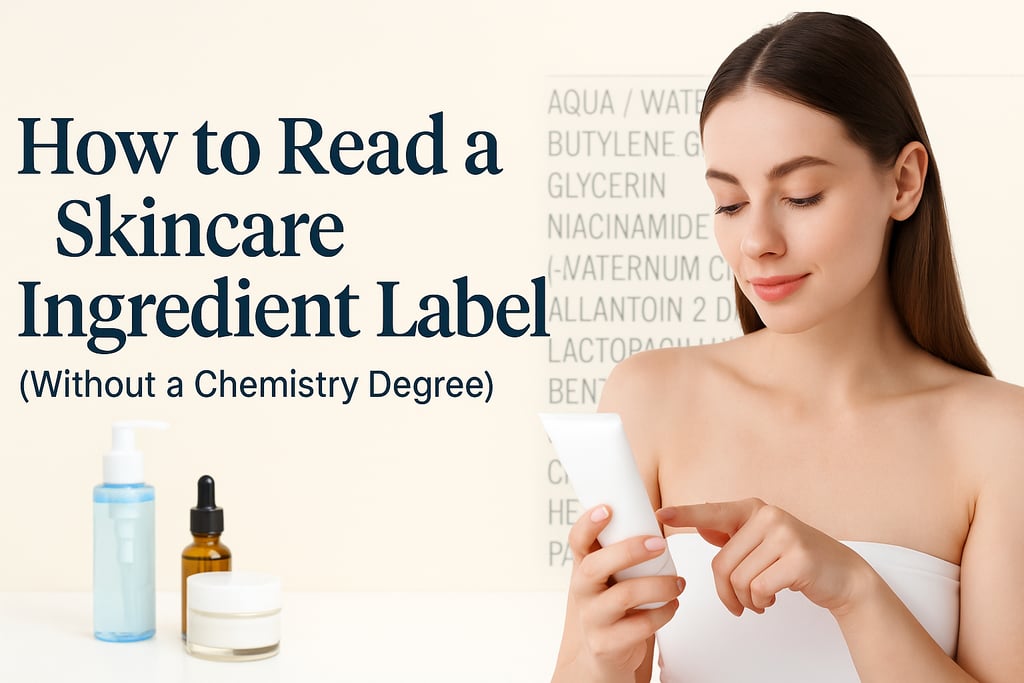How to Read a Skincare Ingredient Label (Without a Chemistry Degree)
Let’s be honest. You flip over a bottle of moisturizer, skim the ingredients, and think: "Why does this feel like reading a science textbook?" If you’ve ever felt lost in a sea of long chemical names, don’t worry — you’re not alone. The good news? You don’t need to be a chemist to understand what’s inside your skincare. Just a little ingredient know-how can go a long way in helping you shop smarter, avoid irritation, and build a routine your skin actually loves. Let’s break it down.
7/28/20252 min read


How to Read a Skincare Ingredient Label (Without a Chemistry Degree)
Let’s be honest. You flip over a bottle of moisturizer, skim the ingredients, and think:
"Why does this feel like reading a science textbook?"
If you’ve ever felt lost in a sea of long chemical names, don’t worry — you’re not alone.
The good news? You don’t need to be a chemist to understand what’s inside your skincare.
Just a little ingredient know-how can go a long way in helping you shop smarter, avoid irritation, and build a routine your skin actually loves.
Let’s break it down.
🧪 What Is the INCI List?
First things first — that long, complicated list on the back of your product? It’s called the INCI list, which stands for International Nomenclature of Cosmetic Ingredients.
Why the fancy names?
Because brands must use standardized ingredient names — sometimes in Latin — to stay consistent worldwide. That’s why water becomes Aqua, and Vitamin E becomes Tocopherol.
📝 How it's organized:
Ingredients are listed from highest to lowest concentration (except for those under 1%, which can appear in any order at the end).
The top 5 ingredients usually make up 80 to 90 percent of the product — and they matter most.
🔍 How to Actually Read the Label
Here’s a simple guide to reading any skincare label without feeling overwhelmed:
✔️ 1. Check the First 5 Ingredients
These make up the majority of the formula. Are they water, glycerin, or plant extracts? Good start. Alcohol denat or parfum in the top 5? Might be a red flag for sensitive skin.
✔️ 2. Don’t Be Alarmed by Actives Lower on the List
Ingredients like retinol, peptides, or salicylic acid are often effective in small concentrations. So seeing them lower on the list doesn’t mean they’re useless — just potent.
✔️ 3. Look for Beneficial Ingredients
Scan for skin-friendly ingredients like:
Hyaluronic Acid (hydration)
Niacinamide (brightening, oil control)
Ceramides (barrier support)
Centella Asiatica (soothing)
Panthenol (moisture + calming)
✔️ 4. Be Cautious with These
Fragrance/Parfum – can irritate sensitive skin
Essential Oils – natural, but not always gentle
Drying Alcohols – like alcohol denat, often in toners
Sulfates – may strip skin in cleansers
🧠 Ingredient Decoding Tips
You don’t have to memorize everything. But these tips will help you feel more confident:
✅ Use Tools
Apps like INCI Decoder, Paula’s Choice Ingredient Dictionary, or EWG Skin Deep help you break down what’s in a product, fast.
✅ Don’t Fear the Scientific Names
Tocopherol is just Vitamin E. Sodium Hyaluronate is a form of Hyaluronic Acid. Many “scary” names are perfectly safe — or even great for your skin.
✅ Marketing ≠ Truth
Just because the front says “clean,” “natural,” or “gentle” doesn’t guarantee anything.
Always check the back.
🛍️ Editor’s Picks: Products with Easy-to-Read Labels
Want to shop smarter? Start with products that are simple, transparent, and packed with gentle ingredients.
🌿 Klairs Supple Preparation Toner
Hydrating and fragrance-free — perfect for beginners.
💧 Pyunkang Yul Moisture Serum
Simple formula, great for hydration and calming redness.
🐌 COSRX Advanced Snail Mucin Essence
Unique ingredient, but well-tolerated and effective.
🧴 Etude House Soon Jung 2x Barrier Intensive Cream
Barrier repair made easy. Minimal ingredients, maximum skin love.
✨ Find them at PinknBlossom.com — with free samples and fast shipping across US and Canada on orders $65 CAD and up.
✅ Final Thoughts: Knowledge Is Power (Even Without a Lab Coat)
Reading skincare labels doesn’t have to be complicated.
Once you understand how to scan for the good stuff — and spot the potential troublemakers — you’ll feel more confident choosing products that work for your skin, not against it.
It’s not about being perfect. It’s about being informed.
And the more you know, the better your glow.
💬 Want More No-Fluff Skincare Tips?
We’re all about simplifying beauty.
Head to Dealaha.com for more guides like this, clean product picks, and smart skincare advice you can actually use.
Quality You Can Trust
Discover handpicked, high-quality products that support a healthier, more intentional lifestyle.
Contact
Stay in the Loop
© 2025 Dealaha™ All rights reserved.
